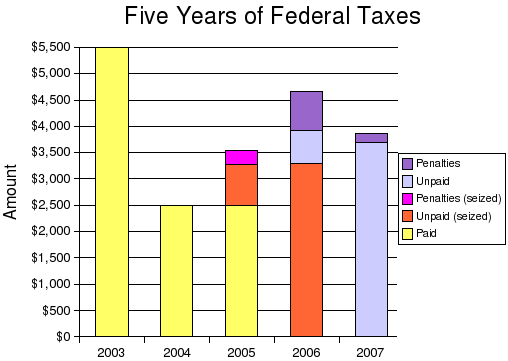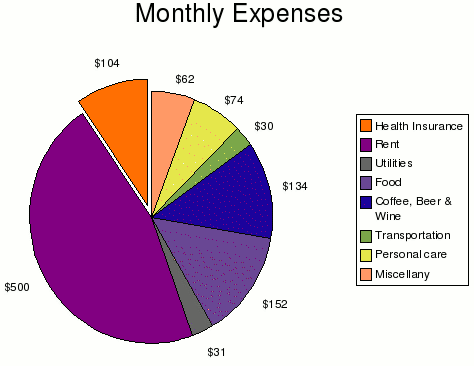This report summarizes . At the end of some sentences, I’ve put links to previous Picket Line entries that expand on some of the topics I mention. You can follow these links by clicking on the ♦ symbols.
Picket Line Annual Report
, the invasion of Iraq began and I quit my job to start an experiment in tax resistance.♦
A review of my goals
My primary goal at the time was to stop financially supporting the U.S. government. I hoped to do this by legally reducing my federal income tax burden to zero — lowering my income below the tax threshold by taking legitimate deductions and credits.
Tax Resistance
In I missed my goal of avoiding all federal income tax, but in the following tax years I succeeded. However, I have had a self-employment tax assessment each year. In I decided to stop voluntarily paying this self-employment tax, and so I have been charged penalties & interest in addition to the assessed tax. , for the first time, the IRS started levying my bank accounts to seize these back taxes.♦
This two-track strategy of legally avoiding the federal income tax while illegally refusing to pay FICA is an awkward and perhaps untenable compromise, but for me it currently seems to be the best alternative.♦♦

So far, the IRS has successfully seized about $4,300 of the total of about $9,600 that I have refused to pay (roughly $8,400 of that is assessed self-employment tax and the remaining $1,200 is interest & penalties). I don’t have an effective plan to hide my assets, so I expect that the IRS will continue to seize money from time to time. I may decide to apply to the War Tax Resisters Penalty Fund to get some relief from the penalties and to help distribute the credit for my tax resistance among more people.♦
Although excise taxes are a very small part of what the government tries to get me to pay, I’ve adopted avoidance techniques here as well: for instance, I home-brew beer to avoid the federal excise tax on alcoholic beverages and I long ago gave up owning a car, so I pay very little federal excise tax on gasoline.
Sustainability
I want to resist taxes over the long term, and so it is important that my expenses remain low enough that my tax-free income is also a sustainable one. I’m happy to report that I’m living sustainably and well at my below-the-tax-line income.♦
My regular expenses for things like rent, food, health insurance, transportation, utilities and such come to about $1,090 per month — somewhat less than last year in spite of the widely-reported rise in inflation and in the cost of food and other goods. My utility bills, transportation costs, and food budget are all down from my averages over the past few years. Thanks to Freecycle, our household can frequently find what we need without any expense at all.♦ However, we’ve recently signed up for a Community Supported Agriculture program, which will probably end up increasing our food expenses a bit this coming year.♦
Because I’m self-employed, my health insurance premium is a deductible expense that doesn’t count toward the $15,600 tax-free disposable income that I’m allowed to use under my DON Method of tax resistance (additionally, I qualify for and use a Health Savings Account so my health insurance deductible is also tax-free).

Not included in the above pie chart are any work expenses that I can deduct, and my self-employment tax assessment (half of which I can deduct). My yearly living expenses, therefore, take about $11,800 out of that $15,600. If I budget in the imposed self-employment tax, which I don’t intend to voluntarily pay, but which I expect to lose, this comes to another $3,900, half of which also counts against the $15,600. That leaves me $1,850 in wiggle room, and I’ve got some savings I can work with if something unexpected comes up or if I want to splurge (say, on another south-of-the-border vacation).
My 1040: A walk-through
Here’s how I trimmed my 1040 this year (I haven’t completed my tax forms yet, so these numbers are provisional). First, my Total Income:
| Business income | $26,151 |
|---|---|
| Taxable interest | $438 |
| Ordinary dividends | $155 |
| Capital gain/loss | $2,430 |
| Total Income | $29,190 |
My business income came mostly from two sources: my contract work and sales of my books. The capital gains are attributable to sales of stock and capital gains distributions from a mutual fund.
Now on to my Adjusted Gross Income:
| Total Income | $29,190 |
|---|---|
| HSA deduction | −$2,850 |
| ½ self-employment tax | −$1,847 |
| Self-employed health insurance deduction | −$1,170 |
| IRA deduction | −$4,000 |
| SEP deduction | −$4,500 |
| Adjusted Gross Income | $14,823 |
Here, I’m able to take advantage of the $4,000 I put into my traditional IRA, the $4,500 I put into my SEP plan, and the $2,850 I put into my Health Savings Account, and I can deduct the complete cost of my health insurance premium as well as half of the imposed SECA tax.
That SECA deduction is because I’m self-employed. When you work for someone else, your employer pays half of your FICA and the other half comes out of your paycheck. This is just silly accounting for the most part, but it does mean that half of your FICA doesn’t count as your income and so you don’t pay income tax on it (isn’t that rich — they charge you income tax on money you never saw because it was taken as your contributions to social security — and then they may charge you income tax again on your social security benefits if you’re lucky enough to live so long!). If you’re self-employed, you pay both halves and it’s all considered income, so the IRS lets you take half of your SECA tax as a deduction here to even things out.
I came out about $750 under my $15,600 AGI ceiling, which is plenty close enough for me. I have to leave a generous margin of error in case there are any year-end surprises (this year, those mutual fund capital gains distributions caught me by surprise, and I had to make additional SEP contributions to compensate — it’s a good thing I’d left myself some extra room).
Now we go from Adjusted Gross Income to Taxable Income:
| Adjusted Gross Income | $14,823 |
|---|---|
| Standard deduction | −$5,350 |
| Personal exemption | −$3,400 |
| Taxable Income | $6,073 |
because of qualified dividends and capital gains, I had to use a different method for figuring out the tax due on this amount — I couldn’t just reference the tables in the back of the booklet at this point. This worked to my favor: My tax came to $493, less than it would have by the other method. But it didn’t really matter: By using Form 8880, I get a credit that’s big enough to cover either amount, and which reduces my federal income tax to zero, QED.
Other Goals
I hope to encourage other people to consider tax resistance as a tactic and I hope that The Picket Line is a good resource for people doing tax resistance and for those considering it. I keep trying to make it more useful.
I’ve done some media appearances, in such places as the San Francisco Chronicle, Raising Sand Radio, the Associated Press newswire, Money magazine, John Scott’s show on AM 960 “The Quake”, radio shows for WOR in New York and KIRO in Seattle and KPFA in San Francisco, and the Alan Colmes Show.♦♦♦♦♦♦♦ Some of my writing on this topic has appeared in Peacework Magazine, The Nation, and More Than a Paycheck.♦♦♦
I have also spread the word elsewhere. For instance, I’ve helped put on workshops held by Northern California War Tax Resistance, I’ve sent many an email to people I thought I might be able to nudge into resistance, I’ve injected the tax resistance meme into discussions online and off, and I agitate for tax resistance at peacenik gatherings.♦♦♦
Another of my projects has been to create collections of Henry David Thoreau’s writing on political philosophy. I released two books, The Price of Freedom: Political philosophy from Thoreau’s journals and My Thoughts are Murder to the State: Thoreau’s Essays on Political Philosophy.♦
I’ve also just completed a first draft of my tax resistance reader project — a 600-page behemoth that covers tax resisters and tax resistance campaigns from the Roman Empire to the present day. I’ve put in many long hours on this project and have come up with something that I hope will interest and inspire tax resisters, activists, and others for years to come.
I signed up for the VITA program again this year, and am helping several low-income families take back thousands of dollars from the U.S. Treasury. ♦ ♦ ♦ ♦
The state of the world and the tax resistance movements
The war drags on, and the U.S. torture policy too, undeterred by law or decency, and only ineffectively and rhetorically opposed for the most part.
NWTRCC conducted a survey of anti-war activists that indicated potential support for a large-scale war tax resistance campaign.♦ On the basis of this, the group launched the War Tax Boycott campaign.♦ Although it has been a good vehicle to use to get across the war tax resistance message, as a campaign it has been disappointing. Without funding, support from large anti-war groups, or publicity, it has been unable even to rally a significant number of those activists who are already tax resisters.♦
However, it’s fair to say that the war tax resistance movement had more than its usual share of influence and growth in the anti-war movement last year. Code Pink & Christian Peace Witness for Iraq each launched their own war tax resistance campaigns, independently of the War Tax Boycott.♦♦
Prospects for the coming year
Assuming no major unexpected expenses, and assuming the tax law stays roughly the same this year, I’m well-positioned to have another year of living comfortably and well under the income tax line, though I will “owe” SECA again this year. I’ve budgeted for the likelihood that the IRS will continue to seize money from me this year for unpaid back taxes, so in case this happens, it won’t slow me down.
I’ve applied to join the Administrative Committee of NWTRCC. If I’m accepted, this will mean that I’ll become less of a Thoreauvian lone wolf and more of a movement-oriented tax resister. It’ll also mean I’ll be more intimately involved in the national war tax resistance movement and with the various regional war tax resistance groups, and I’ll probably have some interesting stories about that to share here.
